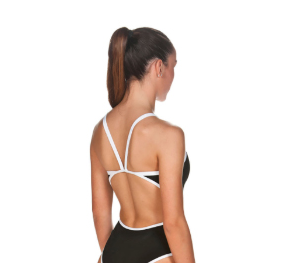The arena Carbon Duo is Revolutionary in Women’s Competition Swimwear

Last month, arena launched a new technical racing suit called the POWERSUIT Carbon Duo. It is the first technical racing suit for women composed of two separate pieces: a top carbon band and a bottom carbon cage. Elite swimmers can now customize their racing suit based on their body type, size and color choice. The options are endless and parts are replaceable allowing for cost control.

The Carbon Duo options are revolutionary in the swimsuit industry for a number of reasons, mostly because these suits are faster for the athlete to put on vs the traditional one-piece racing suits of the past.
“The bottom is built with our proprietary fabric which is made with our carbon cage for high compression. The top consists of our extremely lightweight fabric with carbon bands, resulting in a light compression that feels tight, yet you have space to breathe comfortably and have more freedom of movement in the shoulders.
“The internal lining is designed with two separate panels, weighing less, and giving you more flexibility. You have options to choose different sizes for your top and for your bottom, to fit your figure. Since you can buy them separately, that means you can replace them individually, and modify or update your arena Carbon Duo system for less cost.
“With arena’s new Carbon Duo, women will “no longer be squeezing their body into your suit until their fingers bleed” and there will be “no more uncomfortable straps on the swimmer shoulders.” There will be “no more choosing between compressed thighs” and “no more selecting one size over another.” – arena
More importantly, the arena Carbon Duo suit is FINA approved!

“We noticed that there are a lot of differences in how people, especially girls, fit their racing suits in different countries,” said co-CEO of arena Giuseppe Musciacchio. The full body suit is always a difficult product to fit because you have to combine the top part and the bottom part that not necessarily are the same for everybody.”
“We asked ourselves what if we could create a suit that allows more freedom in the choice of the fit of the top part and bottom part of the body. We realized the official rules in place by FINA were allowing a two-piece suit. Normally when you think of a two-piece, you think of a bikini. That’s where we got the idea of the Carbon Duo. It’s not a bikini and when you put it on, it’s combined into a full body suit. When you see it done, it’s not rocket science.” – Giuseppe Musciacchio
Women’s Competition Swimwear Historical Perspective
So how did we get here? Let’s start from the current era of racing suits back to the beginning of swimming apparel for women in the late 1800’s.
In recent years there have been a number of suits on the market allowing for compression while meeting FINA standards that disallowed full-body suits and material that was impenetrable. The results were suits that were one piece suits.

Photo Courtesy: ISHOF
In 2009, arena launches the X-Glide and Jaked released a suit that was made out of pure polyurethane. The suits were responsible for a slew of world records at the World Championships in Rome. During the Championships, FINA voted almost unanimously to ban these suits. The new vote restricted male swimsuits to cover the area from the waist to the knee, and women’s suits from the shoulder to the knee.
These new rules caused swimsuits to be made out of strictly textile materials and the suit companies tried to emulate the compression of the polyurethane body suits. The textile suits, although covering less skin, would still take an extended period of time to put on.

Photo Courtesy: ISHOF
In 2008, Speedo introduces the LZR full body suit, with state of the art fabrics designed for more body compression and drag reduction

Photo Courtesy: ISHOF
In 2000, SPEEDO introduced the Fastskin line of swimsuits. Based on the qualities of a shark’s skin, the new fabric has less friction and drag than the human skin. More advances are made in design and fabric with the Fastskin Pro in 2004.

Flyback Photo Courtesy: arena
In 1980, arena introduced the Flyback®, which was the world’s first competition swimsuit designed with thin straps to create larger shoulder openings and an exposed back in order to give athletes complete upper body range of motion.
At the 1972 Games in Munich, sports visionary Horst Dassler, son of the founder of adidas and President of Adidas France, was on the pool deck to watch Mark Spitz win seven gold medals and set world records in each race. Dassler immediately started forming plans for a swimwear company dedicated to aquatic sports and created the new performance swimwear brand known today as arena.

Photo Courtesy: ISHOF
After WWII, nylon replaced silk and wool as the fabric of choice for competitive swimwear. In 1964 FINA permitted color and in 1973, the ”modesty panel” was eliminated. From the 1970s through early 1990s, swimsuits became smaller, designers believed “nothing is faster than skin.” In 1972, Nylon-elastane (Lycra) was the first of revolutionary new fabrics to be used by Speedo at the Olympic Games in Munich. At those Games, the East German team adopted suits that were skin tight that tightly followed the body shape.

Photo Courtesy: ISHOF
In 1926, Gertrude Ederle introduced the first two-piece bathing suit purely by accident. While practicing for swimming the English Channel, her stomach was getting chafed by the wool suit and salt water, so she cut the midsection.

Photo Courtesy: ISHOF
Starting with the 1920 Olympic Games women’s swim suit legs were shortened but were required to have a short skirt, known as a “modesty panel.”

Photo Courtesy: ISHOF
In 1912, women’s swimming and diving joined the Olympic program for the Stockholm Games. There, the women were required to cover up with robes before entering the water, and immediately after leaving the water. By now, manufacturers realized swimwear had been designed without functionality in mind. As the sport grew at the start of the century, swimsuits became more streamlined and less heavy.

Photo Courtesy: ISHOF
When Australian swimmer Annette Kellerman came to the United States as a “diving venus” in 1907, she was appalled by the costumes women were required to wear to go swimming in the US and decided to stage a one woman protest. A year later, Kellerman was arrested on a Boston beach for indecent exposure. She was wearing a one-piece bathing suit that exposed her arms and legs and showed off much of her figure, similar to what the men’s swimsuits were at the time.
She brought to court a man’s suit onto which she had sown leggings, making a one piece suit that technically conformed to the law. The sympathetic judge agreed to drop the charges against her in return for her promise to only wear this swimsuit. Kellerman’s actions were dramatized in the film, “Million Dollar Mermaid” with Esther Williams portraying Kellerman.

Photo Courtesy: ISHOF
In the 1800s, women were required to wear long-sleeved, full length wool or flannel bathing costumes with weighted hems to keep the dress from exposing the bloomers and stocking underneath. Moralists believed women needed to cover up in the water to distract the men from the power of lust. While these costumes allowed women to swim, they were so heavy when wet that oftentimes women would not swim and drowning was the leading cause of death. Most swimming facilities were restricted for men only and most women refused to swim in the heavy costumes so very few women knew how to swim.
Could the Carbon Duo be the new trend for women’s swimsuits?
“It’s difficult to say now,” Musciacchio said. “At the end of the day, that’s the way innovation works. You could have 100 ideas and 99 may be forgotten and one could change people’s lives.”
Sweden’s Sarah Sjostrom also commented on the suit at the FINA Champions Series in Indianapolis this year.
“I really wish there was something like that when I started swimming. I think that would be the suit I would like to wear (when I was younger). Now, I’ve been racing for such a long time with the suit I’m wearing so it’s really hard to change back to it. But I think it is really a good suit for a lot of swimmers.” – Sarah Sjostrom
As you can see, swimwear for women have come a long way and in some cases full circle.
Visit the International Swimming Hall of Fame to see many of these suits on display.

Photo Courtesy: ISHOF
Bruce Wigo and Andy Ross contributed to this article.




Brittany Biggs
Lisa Yeingst- Biggs I feel like thats the one I want to try (at least try on)
Lisa Martin
Zarrie Martin best you get training then xx
Maddy Casswell
Natalie Goodall
The Arena Carbon Duo is revolutionary in womens competition swimwear, offering unparalleled performance and comfort. While it’s designed for competitive use, its innovative technology and fit can inspire the design of other swimwear categories, including the stylish <a href=“https://girltalkswimwear.com/collections/top”> affordable bathing suits </a>.